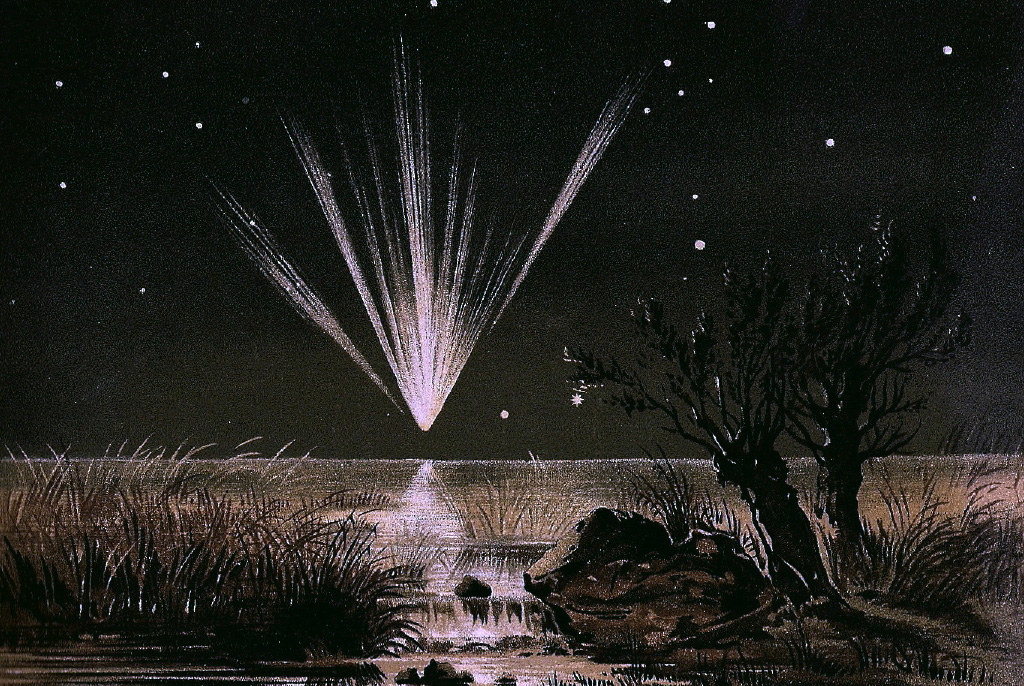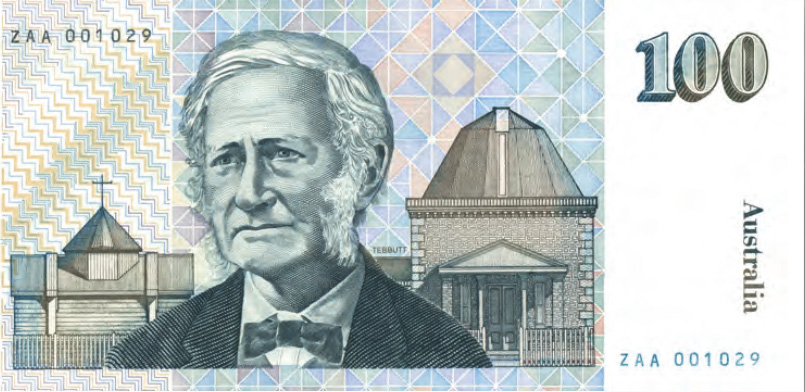
Perihelion: 1861 June 12.01, q = 0.822 AU
Two of the brighter comets of the latter half of the 19th Century were discovered by an Australian amateur astronomer, John Tebbutt, who for four decades essentially ran a one-man astronomical clearinghouse from his private observatory near Windsor, New South Wales. In addition to numerous astrometric observations of asteroids and comets, he also maintained detailed studies of the weather as well as a local time service, and also wrote prodigiously on scientific topics for the general public. His scientific contributions were such that the Australian government placed his portrait on the back of the AUS$100 banknote from 1984 to 1996.
Tebbutt discovered his first, and brighter, comet – and, indeed, one of the brightest and most spectacular comets of the entire 19th Century – on May 13, 1861, at which time it was about 4th magnitude, and located at a declination of -30 degrees in the constellation Eridanus and traveling very slowly northward. Such was the state of communications at the time that Tebbutt was the only observer of the comet for a few more weeks, but during the second week of June it began to be picked up by other observers as a relatively bright object of 2nd magnitude with a distinct tail that some reported as being close to 40 degrees long. Although the comet passed through perihelion on the 12th it continued to approach Earth and to brighten, and by the last week of June was close to magnitude 0.
Comet Tebbutt passed 0.133 AU from Earth on June 30, passing almost directly between Earth and the sun at that time, thus briefly exhibiting a phase angle in excess of 165 degrees and accordingly a dramatic brightness enhancement due to forward scattering of sunlight. It was traveling northward at over 10 degrees per day at the time, and right around the 30th suddenly became visible from the northern hemisphere as a brilliant object of magnitude -2 or brighter. Because of the viewing geometry the tail was broad and structured, and according to several observers stretched over 90 degrees on the sky. Several observers reported the comet as being bright enough to cast shadows. It appears that Earth might actually have passed through part of the comet’s tail around the time of closest approach.

During the first few days of July Comet Tebbutt entered northern circumpolar skies, and for the first week of that month remained a bright and spectacular object of 1st magnitude with its tail extending for a length of 60 degrees or more. It began fading after that, although it was still close to 3rd magnitude, with a tail over 10 degrees long, around mid-July, and was close to 4th magnitude by the end of that month. The comet dropped below naked-eye visibility around the middle of August and remained telescopically detectable until the beginning of May 1862, by which time its heliocentric distance had increased to 4.4 AU and it was located within 13 degrees of the North Celestial Pole.
Being as bright and spectacular as it was, and especially with its dramatic and sudden appearance in the northern hemisphere’s sky at the end of June 1861, Comet Tebbutt appeared in numerous popular writings of the time. Its appearance came only 2½ months after the start of the American Civil War, and Commander Raphael Semmes, Captain of the Confederate Navy’s commerce raider CSS Sumter, wrote of viewing the comet while that vessel made its escape from the Union blockade of New Orleans on the evening of June 30. Meanwhile, on July 6 the British explorer of Africa David Livingstone, while in present-day Malawi commanding the Second Zambezi Expedition, independently discovered the comet while it was traversing Ursa Major north of the Big Dipper.
Orbital calculations, based in part upon some of the astrometric measurements that Tebbutt himself collected, suggest that Comet Tebbutt has an orbital period of slightly over 400 years, in turn suggesting that it might have returned sometime around the mid-15th Century. In 1995 Japanese astronomers Ichiro Hasegawa and Syuichi Nakano proposed that a comet observed from China, Japan, and Korea in May and June 1500 might be identical to Comet Tebbutt, and successfully linked the orbits of the two comets mathematically. If the two comets are indeed one and the same object, Hasegawa and Nakano predict that it will return to perihelion again in December 2265. At that time it will be on the opposite side of the sun from Earth and thus would be nowhere near as spectacular as it was in 1861, although with its near-perpendicular orbit (inclination 85 degrees) it would presumably still be visible after perihelion without too much difficulty.
More from Week 27:
This Week in History Special Topic Free PDF Download Glossary
Ice and Stone 2020 Home Page


